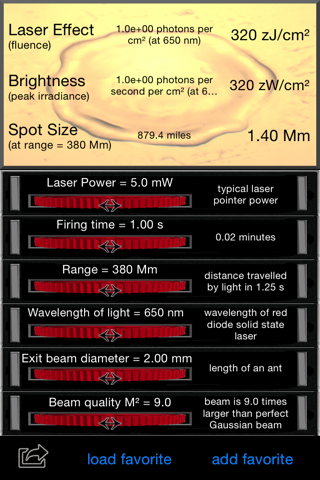
Laser Effect Calculator app for iPhone and iPad
Developer: Onekala LLC
First release : 16 Sep 2014
App size: 4.33 Mb
Explore the world of lasers and optics with the interactive Laser Effect Calculator.
- See the resulting laser effect, laser brightness and laser spot size when you change the laser power, firing time, range to object, wavelength of light, exit lens diameter and beam quality
- The app uses Gaussian physics and thermodynamics to estimate how much of a material you can melt, or how many photons arrive, taking into account the variables above
- Values are displayed in accurate scientific notation - change them precisely over 40 orders of magnitude with customized sliders, and pause at a value for half a second to lock in the selection.
- Load scenarios to explore high-power lasers like the National Ignition Facility (laser fusion), long range scenarios like laser orbital debris removal, or see how a low power laser can be used to write a CD, DVD or Blu-ray Disc
- Create your own scenarios for education, research or homework, and save them to your favorites. Also you can submit favorites to be included in the next release
- Laser Effect Calculator is for educational use only, as many assumptions are made:
—The circular laser beam propagates according to Gaussian physics
—A perfectly collimated beam is focused by one lens to a beam waist
—The laser beam is not affected by atmospheric absorption, scattering or thermal blooming
—The phase front of the beam is perfectly corrected for aberrations
—The focusing optic has a focal length equal to the distance Range
—The focusing optic is sized to avoid clipping
—The spot size reported is the beam waist, is not diffraction limited, and is measured at the 1/e2 values of irradiance
—The beam has a Gaussian spatial profile and a flat-top (not Gaussian) time profile
—The beam waist occurs at the focal length (even though at long distances it occurs earlier)
—For melting calculations, it is assumed that all laser energy is absorbed, and all second-order effects like variation of specific heat with temperature are ignored



